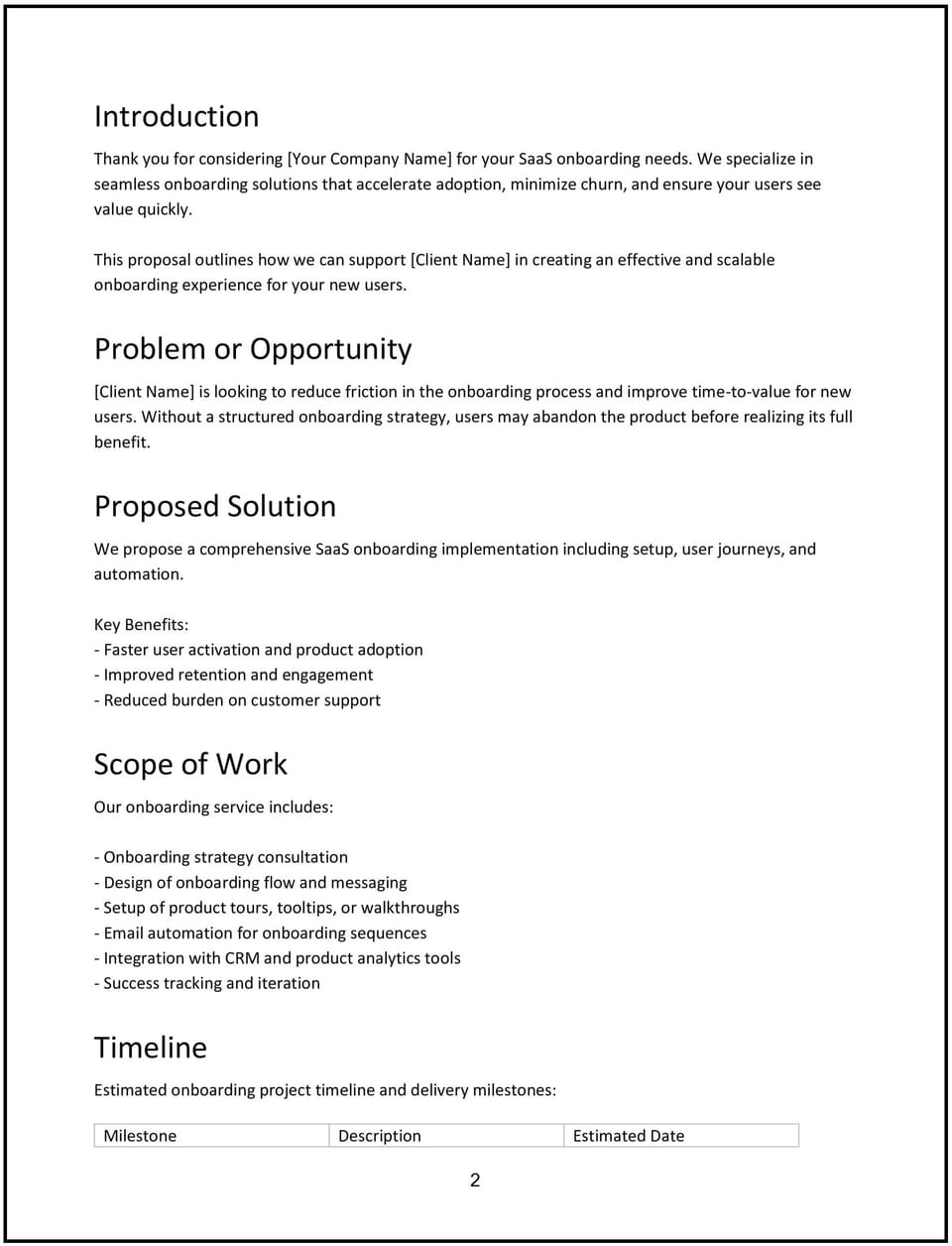SaaS onboarding proposal: Free template

Customize this free SaaS onboarding proposal with Cobrief
Open this free SaaS onboarding proposal in Cobrief and start editing it instantly using AI. You can adjust the tone, structure, and content based on your product, client type, and onboarding workflow. You can also use AI to review your draft — spot gaps, tighten language, and improve clarity before sending.
Once you're done, send, download, or save the proposal in one click — no formatting or setup required.
This template is fully customizable and built for real-world use — ideal for proposing onboarding services, outlining implementation plans, or helping clients go live with your product. Whether you run a SaaS company or offer onboarding as a service, this version gives you a structured head start and removes the guesswork.
What is a SaaS onboarding proposal?
A SaaS onboarding proposal outlines how a customer will be guided through the process of setting up, learning, and getting value from a software product. It typically includes the onboarding timeline, key deliverables, roles and responsibilities, and pricing (if applicable).
Use this proposal when you want to:
- Provide clarity on how onboarding will work after a sale closes
- Define who does what between your team and the client
- Accelerate time-to-value and reduce churn risks
- Set expectations around configuration, training, and support
This type of proposal is used by SaaS teams, onboarding specialists, or implementation consultants working with mid-size to enterprise clients. It often leads into a kickoff or agreement to proceed.
Why use Cobrief to edit your proposal
- Edit the full proposal instantly: No uploading or setup — start editing in your browser.
- Use AI to rewrite or adapt sections: Tailor messaging based on the client’s industry, size, or use case.
- Run an AI-powered review: Catch vague deliverables, unclear timelines, or missing outcomes.
- Apply AI suggestions in one click: Refine manually or accept all edits instantly.
- Save, send, or download in seconds: Share the proposal as a live link, email, or PDF without leaving the platform.
When to use this proposal
- When a deal is about to close and onboarding needs definition: Set expectations clearly to ensure a smooth transition from sales.
- When providing paid implementation services for new customers: Quote the scope, timeline, and deliverables involved in getting started.
- When onboarding an enterprise or high-touch client: Lay out milestones, roles, and support levels for complex rollouts.
- When offering onboarding as a service: Propose structured onboarding to clients using third-party SaaS tools.
- When handing off from sales to customer success: Provide a formal onboarding plan to internal stakeholders or the client.
What to include in a SaaS onboarding proposal
- Client summary: A quick description of the client’s business, use case, and goals with your software.
- Onboarding objectives: A clear statement of what success looks like by the end of the onboarding process.
- Scope of onboarding: A breakdown of activities like data import, configuration, integrations, training, and check-ins.
- Timeline: A week-by-week or phase-based timeline showing how the onboarding process will unfold.
- Roles and responsibilities: A clear list of who is responsible for what, on both the client and provider side.
- Support and resources: A list of materials, contacts, or tools the client will have access to during onboarding.
- Next steps: A call to action — such as booking a kickoff call, approving the scope, or signing a contract.
How to write an effective SaaS onboarding proposal
- Align with the client’s goals: Show that your onboarding plan is tailored to what the client wants to achieve with the software.
- Be specific about deliverables: Spell out exactly what your team will do — don’t assume it’s obvious.
- Simplify where possible: Break complex workflows into clear phases or steps the client can follow.
- Avoid jargon: Use plain language, especially for non-technical clients or stakeholders.
- Use proof points: Reference successful onboardings or metrics like time-to-first-value.
- End with a clear CTA: Help the client understand what happens next — don’t leave it open-ended.
Frequently asked questions (FAQs)
Can I reuse this for different onboarding clients?
Yes — just update the scope, timeline, and objectives to reflect each client’s setup and goals.
Can I edit or remove specific sections?
Absolutely. Every section is fully editable, and you can customize it to fit your onboarding model.
Can I use this for paid onboarding services?
Yes — you can include pricing, deliverables, and terms if you charge for onboarding separately.
Can I send this proposal as a PDF?
Yes — once finalized, you can download a professional-looking PDF with one click.
This article contains general legal information and does not contain legal advice. Cobrief is not a law firm or a substitute for an attorney or law firm. The law is complex and changes often. For legal advice, please ask a lawyer.